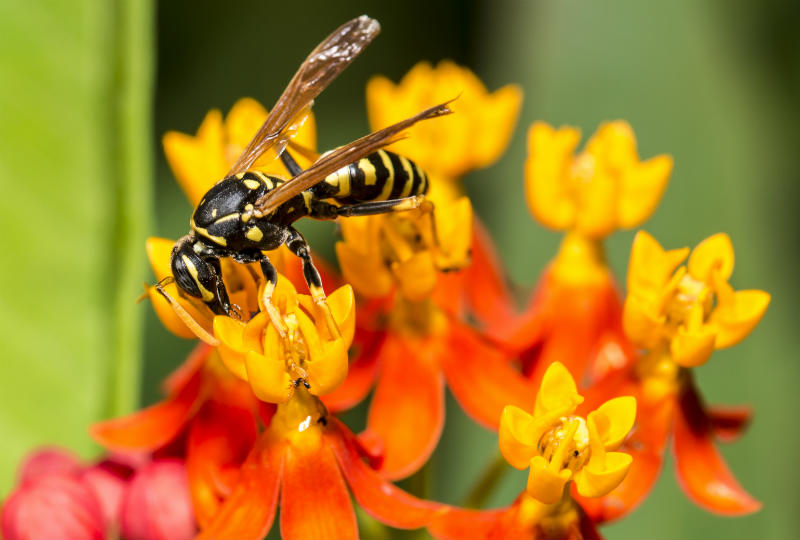Flying, stinging insects can be more aggressive in the early fall. Learn your risk for serious reactions.
As summer gives way to crispness in the air, Southerners fill the time before winter with picnics, hiking and sporting events. Flying, stinging insects are getting more active, too, leaving people who might not realize they have life-threatening allergies vulnerable to stings.
“Fall in the South is an ideal time for dinners on the deck, outdoor concerts and football games. But those are all areas that attract yellow jackets, wasps and other scavenger insects that are more aggressive this time of year,” said Stokes Peebles, M.D., of the Vanderbilt Asthma, Sinus and Allergy Program. “While insect stings may occur anytime between the last and first frosts, people are more prone to being stung during late summer and early fall because insects such as yellow jackets are more agitated when it is hot and dry. Their water sources are less available. They are hungry and competing to harvest food that becomes scarce in the winter.”
This makes it important to educate people who don’t know they have “hymenoptera hypersensitivity,” the technical term for what most people commonly call a “bee sting allergy.”
This condition is one of the leading causes of death from an acute allergic reaction called anaphylaxis, with about 50 fatalities in the U.S. each year. And it’s almost completely preventable and controllable.
Stings from insects are the third leading cause of emergency room visits for anaphylaxis each year in the United States. The main culprits are honeybees, yellow jackets, wasps, hornets and fire ants. (Beekeepers beware: Although bees are less aggressive in terms of stinging, an actual bee-sting allergy is more likely than those of yellow jackets or wasps to cause severe anaphylaxis.)
Have you had these reactions after a sting?
The clearest sign of an allergy is if you are stung by a flying insect – not bitten, like by a mosquito – and within an hour have a systemic reaction, with symptoms that happen beyond the pain and swelling at the site of the sting.
Signs someone could be at risk for life-threatening anaphylaxis with a future sting:
- A burning sensation and itching throughout the body;
- Itching, swelling, hives, a rash or any other reaction in a place that is not next to where the sting happened. For example, the sting is on the hand, but the scalp starts to tingle and itch;
- A feeling of thickness in the throat;
- Tightness in the chest, difficulty breathing or wheezing;
- Swelling of the tissues underneath the skin;
- A drop in blood pressure.
If you see this reaction in yourself or others, it is crucial to act quickly. If you have noticed it in the past but the symptoms were controllable at the time, testing is in order. The next insect sting could be much more serious.
Anaphylaxis progresses rapidly, and the essential first-line therapy to prevent possible death is always epinephrine injection, Peebles said. Epinephrine is available in auto-injector form (a common brand is EpiPen); the patient pushes the container against the front or side of the thigh and a needle ejects to deliver medication. This form is available in doses appropriate for children and adults. Epinephrine is also available in vials, from which the patient draws medication into a syringe.
The importance of testing
Diagnosis and treatment of hymenoptera hypersensitivity are rather simple. Through the Vanderbilt Asthma, Sinus and Allergy Program, skin and/or blood tests can pinpoint the risk for people who have experienced anaphylaxis.
Skin testing should be performed at least 4-6 weeks after the reaction because the person may not have a positive test immediately after anaphylaxis. Skin testing is the best test because it is accurate in a higher percentage of patients than blood testing, but the blood testing is added to ensure proper diagnosis.
Another reason testing is important: Studies show that people often misidentify the type of insect during a string. Testing sorts that out so the patient can get the correct type of allergy shot.
Overall, diagnosis takes two office visits at most.
Desensitizing the immune system through allergy shots is often the more efficient and safer treatment route.
While an epinephrine auto-injector is sufficient for most people, the danger is that patients can forget to carry them all the time – especially while playing sports or hiking, when a person might be more exposed to stinging insects.
Allergy shots are very effective in preventing future life-threatening reactions and often can be stopped after 4-5 years of regular use.
Some advice for everyone enjoying the great Southern fall outdoors: The best way to avoid allergic reactions to insects is, obviously, not to get stung. Wearing drab-colored clothing with long sleeves and long pants can help. Bright colors are thought to attract insects, and covering the body decreases the skin available for stings.

If you or a loved one has had an allergic reaction to a stinging insect, explore your risk of for hypersensitivity by visiting Vanderbilt Asthma, Sinus and Allergy Program for an evaluation and the most up-to-date treatment recommendations.
Allergies, asthma and sinus problems can produce similar symptoms, ranging from annoying to life-threatening. The Vanderbilt Asthma, Sinus and Allergy experts give you an accurate diagnosis and treatment tailored to you, your symptoms and your life. Vanderbilt Asthma, Sinus and Allergy has five locations in Middle Tennessee: Nashville, Brentwood, Franklin, Gallatin and Lebanon.

